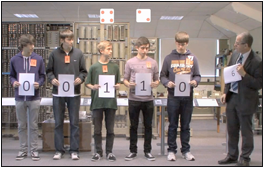
Digital machines such as computers can only detect if electricity exists at a certain point or not (on or off) – which are represented as 1s and 0s.
Computers therefore have to represent everything in binary data (1s and 0s). Text, numbers, pictures, sounds or video – all are represented in binary by the chips (processors) inside a computer, tablet or smart phone.
The operating system and program software convert program data into binary data so that the hardware can process it correctly and make it all work correctly. When a user saves a file on a computer the data that gets saved is all binary. This is much more complicated to understand so this element of how computers work is usually hidden away from the user through a suitable software interface.
Place values in decimal are all the powers of 10 (mathematically this is base 10).
Place values in binary are all the powers of 2 (mathematically this is number base 2).
Therefore column headings double as you move left and half as you move right.









